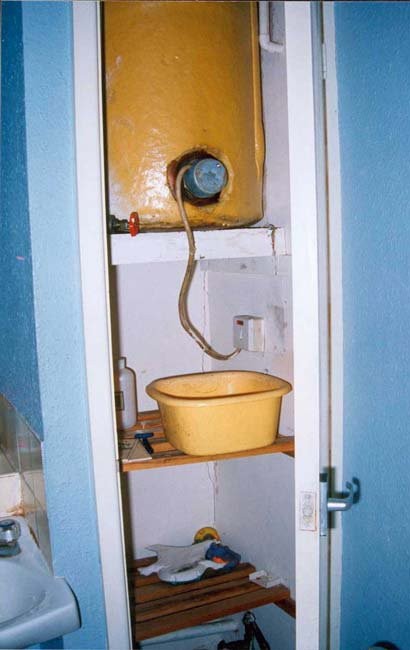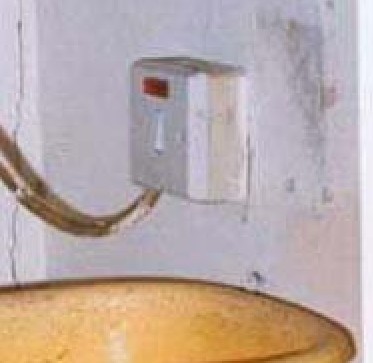



ELECTRICAL
Vulnerable group
Related hazards
Persons aged under 5 years
Damp and mould growth
HHSRS VERSION 2
Multiple locations
Yes
No
Secondary hazards
Yes
No
Front elevation
1950s 3 bedroomed terraced house
A) Supply, meter and fuses
DESCRIPTION OF HAZARDS
Dwelling:
Background: This is a end-terraced house built in the 1950s. Hot water is normally supplied by a
gas-fired central heating boiler, but the early, foam insulated, hot water cylinder also has an electric
immersion heater.
A) Immersion Heater:- The gasket around the hole where the immersion heater enters the cylinder
has perished resulting in a small but continuous leak. Water is not only running down the loose
electric lead to the heater, but also onto the timber shelf holding the cylinder and down the side wall
of the airing cupboard on which the switch to the immersion heater is located. The plaster skim
and plasterboard above and behind the switch box is now thoroughly soaked. The householder
has placed a bowl to catch any directly dripping water.
A
# Secondary hazards
A
2
-
None
-
-
-
-
-
-
Key
3
Seriously defective
3
2
Defective
3
1
Not satisfactory
-
-
Satisfactory/NA
Electrical installation out of date
Number and siting of outlets
Fuses and meters
Earthing
Disrepair of installation
Presence of water
Lightning protection system
HHSRS VERSION 2
SEPTEMBER 2004
a
b
c
d
e
f
g
LIST OF RELEVANT MATTERS
LIKELIHOOD & OUTCOMES
Average likelihood, outcomes and HHSRS score for electrical hazards for persons aged
under 5 years in all dwellings, 1997-99.
HHSRS VERSION 2
SEPTEMBER 2004
HEALTH AND SAFETY RATING SYSTEM SCORES
1946-79 House
LIKELIHOOD
1 in
180
Low
High
Average: 16,869
Example
180
< 4200 2400 1300 750 420 240 130
75
42
24
13
7.5
4
2.5
1.5 >
Justification
OUTCOMES
Class I
Class II
Class III
Class IV
Justification
RATING
The water seeping into the switch box could give rise to an electrical accident,
particularly for adults. However, the greatest risk is to children. To reach the affected
area, young children would need to find the cupboard door open and climb the shelving,
although the presence of bathroom toys in the cupboard might encourage this. There
is a further danger that the loose lead could be used to assist such a climb and pulled
away from the heater while switched on.
%
Average: 0.6
2.2
< 0.05 0.15 0.3
0.7
1.5
3
7
15
26
38 >
Av: 8.2
21.5
< 0.05 0.15 0.3
0.7
1.5
3
7
15
26
38 >
Av: 49.2
54.8
< 0.05 0.15 0.3
0.7
1.5
3
7
15
26
38 >
Av: 42.0
21.5
< 0.05 0.15 0.3
0.7
1.5
3
7
15
26
38 >
2.2
21.5
54.8
21.5
Score:
5
There is a possibility that the water collected in the bowl could be spilt over the child
during the climb. This could increase the harm outcomes by, for example, conducting
the electricity through the child's clothing. This increased spread of health outcomes on
top of the above average likelihood would give a hazard score of 334 and a band E
rating.
Average: 2
I
J
Example
A B C D E F G H
334
Score
RATING SCORES AFTER IMPROVEMENT
IMPROVE
Justification
NEW RATING
Av: Nos
Likelihood to
1 in 5,600
Outcomes to
0.5 10.0 46.4 43.1 %
Although the main hazard comes from the switch, this does not appear defective. The
immersion heater needs replacing and rewiring to current standards, ensuring that the
cable is securely fixed. With no other major electrical installation faults in the house,
this would reduce the hazard score to the average for the stock.
Improved
A B C D E F G H
I
J